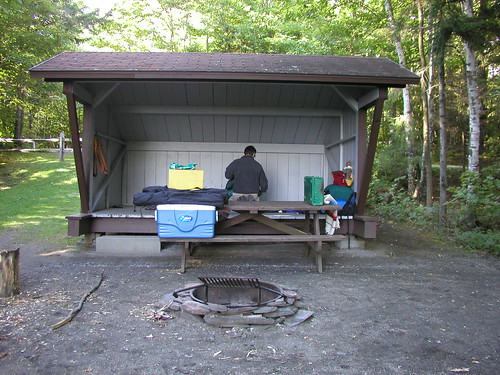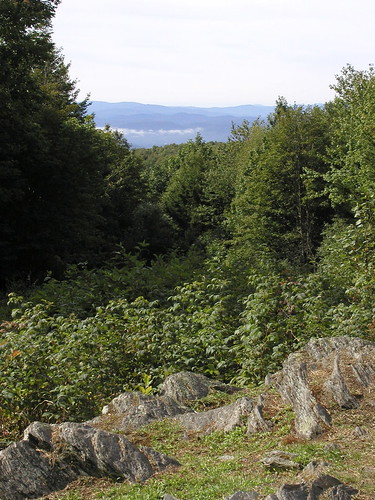 So you can perhaps understand why I was doubtful about taking a family camping vacation, especially when DH said we would rent a 'lean-to', and that we would not need a tent. I had no idea what a 'lean-to' was but it sounded primitive and not particularly fun.
So you can perhaps understand why I was doubtful about taking a family camping vacation, especially when DH said we would rent a 'lean-to', and that we would not need a tent. I had no idea what a 'lean-to' was but it sounded primitive and not particularly fun.We stayed at Allis State Park in Vermont. Turning off the main road (relative term) to get to it, you get the distinct impression that, despite the signpost, you must have made a wrong turn because you drive through what is very clearly a farmyard. Allis is at the top of a mountain, at the end of a dirt road. The park is almost 500 acres of land and the campsite is a very small portion of it. There are only 26 campsites altogether, so if the camp was full there might be as many as 100 people there. There weren't. I think there were two or three other families there the whole time we were there. One night we were the only guests. Given the size of the bathroom facilities, I was very glad there weren't more people there. In the women's room there were two toilets, two sinks (with a sign above reminding people NOT to wash dishes in them), and one coin-operated shower. No dish-washing or clothes-washing sinks, as at the campsites in France!
As it turned out, I was quite impressed by the lean-to and ended up not needing the tent that I had secretly packed in the car. A lean-to is a far more solid structure than its name implies. It's like a very large, extremely solidly constructed, garden shed that is open on one side. The site we rented also included a large wooden picnic table and benches, and a fire-pit.

There was also a beautiful view, included at no extra charge.


We set up a tarpaulin as a canopy over the picnic table which we had moved right in front of the lean-to. At night we dropped the tarpaulin down to add a slight degree of privacy. The front of our lean-to faced away from the rest of the campsite though, so even if it had been fuller, there was plenty of privacy even without the tarp. (The grassy area in the photo below was all part of 'our' site, and the rocks in the photo above were behind me in this one.) Previous visitors over the years had banged nails into the structure at convenient spots and we used those. We strung a rope across the front of the lean-to and used that to hang towels on so they could dry.

The weather was rather cool, especially being at the top of a mountain, so it was quite chilly at night. It did mean there were no bugs though, hence no need at all for the tent I had packed.
Despite the name of the location - Bear Mountain - we saw no bears, or evidence of them. We were awakened every morning, however, by the squirrels trying to get into our cooler and the kitchen box. Vermin! We had to clean their pee and poop off the picnic table before we could have breakfast! (Never had that problem in France, where the table was always inside the tent all night. Occasionally in France we had the kitchen set up outside, but we didn't leave food out there, so no problems with animals trying to eat it.)
Every evening before we went to bed at Allis, we made a ritual walk to the dumpsters to throw all our trash out. DH taught us that it was a good idea to kick the side of the dumpster before throwing anything into it - he said it was better than surprising a critter like a raccoon who would then not be very friendly!
So despite my reservations about going camping without a tent with the man who likes camping in the snow, I enjoyed it and (more importantly) the kids did too. DH may camp without a tent but it's not the primitive camping I imagined it would be. (You still won't catch me going camping in New England in January though, with or without a tent!)




4 comments:
Interesting account, but the Americans should be informed that a 'lean-to' is a shed or outbuilding propped against a wall or building. Oddly enough, the construction in your pictures might be more accurately referred to as a gazebo "A small summerhouse or open hut, especially in a garden, and often positioned to afford attractive views." Gazebo is much posher than Lean-to. ;-)
Well, here in the US, a shelter like this with a low wall in the back and a high wall open in the front is called a lean-to. It's based on the old design where you had sticks for a roof that were leaned against a ridge pole.
In New York State they have a more advanced shelter known as an Adirondack Shelter that has a higher wall in the back, usually with a screened window. It is raised off the ground with a wood floor. In the front is a fireplace built in the middle of the front opening that is accessable from the interior. in the front overhang, there is often a loft space to sleep and a ladder nailed to the wall to get to the loft.
In the summer, there is usually screen stapled across the top of the openings to the left and right of the fireplace with a stick to weigh it down.
In the winter, when these shelters really come into their own, there is plastic across the opening to help hold the heat in. This is when sleeping in the loft is a real treat!
Camping? Poor you. Yeap, bears is something I do have to deal with though, as you might have read! LOL!
Glad you made it OK!
Thank you for sharing
I really like
Post a Comment